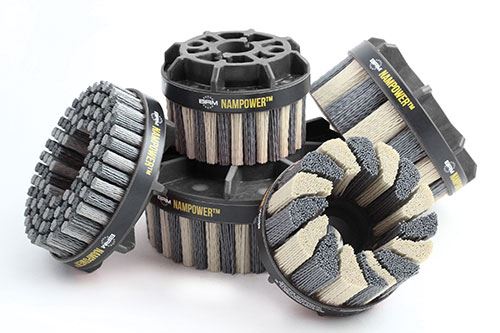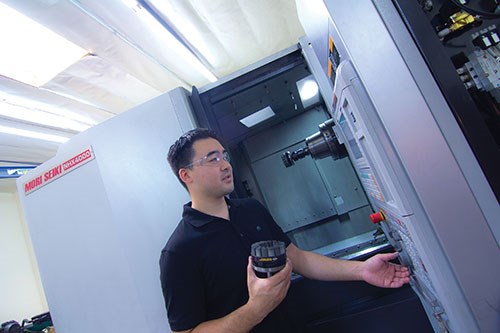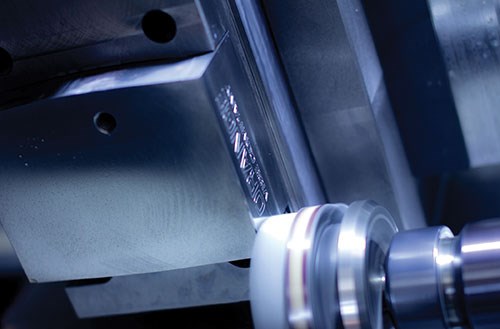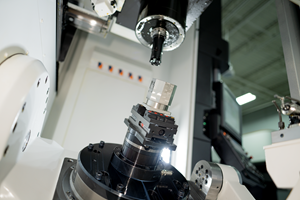Automated Deburring Accelerates Vise Production
Using new Flex-Hone abrasive technology from Brush Research Manufacturing, Orange Vise Co. was able to automate deburring and surface finishing in a single operation.
By automating deburring operations instead of handling them as part of a secondary process offline, CNC part and component manufacturers are reducing labor costs and speeding up high-volume parts finishing. Add to that advances in abrasive technologies that enable machine operators to add surface finishing simultaneously in the same operation, and production improves even further. For Eric Sun, founder of Orange Vise Co. (Orange County, California), the combination of automated deburring and surfacing finishing enabled his company to eliminate several time-consuming and laborious processes to reduce production time.
Founded in 2012, Orange Vise manufactures CNC machine vises and quick-change fixturing components using a Mori Seiki NHX4000 high speed horizontal machining center (HMC). To deburr the vises, machine operators would take the parts offline and address them by hand with a variety of abrasive tools. A messy grinding process was also necessary to achieve a specific surface finish.
The vises are constructed of different materials and surface treatments, and the body is made of cast iron with selectively hardened surfaces. The vises are available in a variety of different sizes with different heat treatments. The hardened surfaces, measuring as high as 50 to 60 HRc, required grinding because milling cutters would wear out too quickly. Out of necessity, Orange Vise would also grind the non-critical, unhardened surfaces to create a uniform appearance over the entire workpiece. This process involved removing, cleaning and repositioning parts several times to grind each face.
“It was time intensive, particularly for the work that was purely cosmetic,” Mr. Sun says.
It was at this time that Mr. Sun discovered a new abrasive tool from Brush Research Manufacturing (Los Angeles, California). The company’s new line of NamPower abrasive disc brushes are designed to automate CNC deburring while delivering a quality surface finish in the same operation. “We started using the NamPower brushes for deburring, but quickly discovered they provided a really nice surface finish,” Mr. Sun says.
Composed of flexible abrasive nylon filaments bonded to a fiber-reinforced thermoplastic base, the NamPower abrasive disc brushes contain a unique combination of both ceramic and silicon carbide abrasive. Although the ceramic abrasive is responsible for material removal, it tends to cut slightly course. However, the silicon carbide acts as a buffer to the cutting action. The combination of the two materials is the key to both deburring and finishing in a single operation.
The abrasive filaments work like flexible files, conforming to part contours, wiping and filing across part edges and surfaces to maximize burr removal rates and improve surface finish. Other common uses include edge blending, part cleaning and rust removal on non-ferrous materials, cast iron, mild steel and ductile iron, stainless and alloy steels, titanium and high nickel alloys.
The product is two available in two fill configurations: dot style, which is well-suited for general-purpose deburring and surface finishing, and turbine style, which has a higher-density fill for more aggressive deburring. To achieve the smoothest finish possible and approximate the ground surfaces of the CNC vise, Mr. Sun says he selected the dot-style brush and intentionally reduced the spindle speed. “The surface finish was good enough that we were actually blending it with our ground finishes,” he says. “With large surfaces that required multiple passes, there were no visible blends. The whole thing looked like it was done in one pass. Needless to say, the brushes sped up the process quite a bit.”
Orange Vise has found the dot-style NamPower brush to be flexible enough to conform to features of varying heights, and it can be used on other parts as well. “We weren’t expecting to use brushes so much, but we’re finding more and more uses for them,” Mr. Sun says. “We use the same brushes for aluminum, steel, cast iron and several other materials without having to swap them out very often.”
In one such application, the company uses the brushes for edge blending. According to Mr. Sun, the the company employs a variety of chamfering tools, including a 45-degree chamfer. Although the tool doesn’t typically leave a burr, it can when it begins to wear. Based on this potential, the company required an employee to inspect each part and remove any burrs by hand. Now the company automatically deburrs chamfered holes and edges using the NamPower Brush.
In addition, Orange Vise engraves the vise jaws using a ballnose end mill. Although the engraving on the underside of the vise doesn’t require deburring, the company wanted finer engraving on the top. To accomplish this, the company used a 45-degree V-bit that created burrs. The options for removing the burrs were either to grind them out or to use the NamPower brush. Mr. Sun opted for the latter. “Grinding would be so much more work,” he says. “With the brushes it really doesn’t take any extra effort at all. It adds maybe 30 seconds to the process.”
According to Brush Research, the NamPower brushes were developed with tool longevity in mind. The disc brushes feature a new tool holder than enables coolant to flow through its center for better lubricant dispersion. This eliminates filament smearing, improves surface finish and increases tool life, the company says. It also permits the brush to run at greater cut depths while reducing heat generation. The brush includes ceramic filaments partially because it is an extremely durable material, the manufacturer says, adding that there are reports of the brush lasting for more than 100,000 parts. The brushes are essentially “self-sharpening” as well. Because of their linear construction, sharp new grains constantly come in contact with the work surface and wear off, exposing fresh cutting particles. This provides consistent deburring action throughout the length of bristles. “We use them just about every day and there’s definitely no difference in performance from day one until now,” Mr. Sun says.
Related Content
Building a 5-Axis Cell
5-axis machining has taken over the metalworking industry, but what goes into a high-functioning 5-axis machining cell?
Read MorePartial Automation Inspires Full Cobot Overhaul
Targeting two-to-four hours of nightly automation enables high-mix manufacturer Wagner Machine to radically boost its productivity past a single shift.
Read More4 Steps to a Cobot Culture: How Thyssenkrupp Bilstein Has Answered Staffing Shortages With Economical Automation
Safe, economical automation using collaborative robots can transform a manufacturing facility and overcome staffing shortfalls, but it takes additional investment and a systemized approach to automation in order to realize this change.
Read MoreChoosing a Five-Axis Machine Tool With Automation in Mind
While much focus is placed on the machinery that moves parts, the features most important for automating five-axis machining are arguably found in the machine tool itself.
Read MoreRead Next
The Cut Scene: The Finer Details of Large-Format Machining
Small details and features can have an outsized impact on large parts, such as Barbco’s collapsible utility drill head.
Read More3 Mistakes That Cause CNC Programs to Fail
Despite enhancements to manufacturing technology, there are still issues today that can cause programs to fail. These failures can cause lost time, scrapped parts, damaged machines and even injured operators.
Read MoreObscure CNC Features That Can Help (or Hurt) You
You cannot begin to take advantage of an available feature if you do not know it exists. Conversely, you will not know how to avoid CNC features that may be detrimental to your process.
Read More














.png;maxWidth=300;quality=90)












